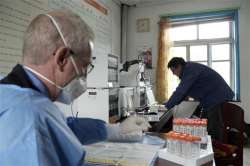US charity helps North Korea fight drug-resistant TB
Washington: Despite worsening U.S.-North Korean relations, an American charity is ramping up efforts against an epidemic of multidrug-resistant tuberculosis in the isolated country, where it says it is making inroads in fighting the deadly disease.The

Washington: Despite worsening U.S.-North Korean relations, an American charity is ramping up efforts against an epidemic of multidrug-resistant tuberculosis in the isolated country, where it says it is making inroads in fighting the deadly disease.
The Eugene Bell Foundation travels to North Korea twice-a-year, bringing high-end equipment and drugs to treat TB patients at old-world facilities. The disease has found fertile ground in North Korea, where the population has been weakened by malnutrition since a famine in the 1990s. The foundation returns this month on a whirlwind, three-week mission to help hundreds of patients.
It appears an unlikely partnership: a Christian-based organization located in Washington, teaming up with an authoritarian government intolerant of religion. North Korea currently faces stiff U.S. criticism for detaining three Americans, including a tourist who is soon expected to face trial after his arrest for leaving a Bible at a sailors' club.
Yet the foundation, which does not proselytize, says it has a good working relationship with the North and its doctors. It started out providing food aid during the famine, but has since mostly helped the nation's creaky health system.
“It's a collaboration, and it works. Our goals are aligned,” said John Rogers, executive director of the foundation, which was set up by the son of a Southern Presbyterian missionary family with long experience in Korea. “Their agenda and our agenda is to save the lives of these people and put a stop to this curable, deadly disease.”
TB is a contagious, bacterial disease that usually attacks the lungs. The World Health Organization, or WHO, estimated about 100,000 new cases of TB in 2012 among North Korea's 25 million people. Dr. Sharon Perry, an epidemiologist who helped start a TB laboratory in Pyongyang, said that incidence of the disease is among the highest in the world outside of sub-Saharan Africa.
North Korea is perhaps unique in how it still houses TB sufferers in a network of sanatoria—specialized clinics used to isolate patients for long-term care—as the U.S. and Europe did in the 19th and 20th centuries before the era of antibiotics.
The sanatoria are poorly supplied, but the foundation says the regimented nature of the North Korean system helps keep track of patients.
Rogers described people wracked by the disease, sometimes carried on the back of a family member, queuing up for help when the foundation visits.
Since 2010, a $48 million program supported by the Global Fund to Fight AIDS, Tuberculosis and Malaria has increased availability in North Korea of regular treatments for TB, principally using the drugs isoniazid and rifampicin. But multidrug-resistant strains, which are more difficult and costly to treat, are widespread, said Dr. Kwonjune Seung, Eugene Bell's medical director.
There's been no nationwide survey of the problem—North Korea still lacks the capability to conduct one—but based on experience at a dozen of these facilities in the southern half of North Korea, Seung predicts such strains could be up to three times more common than the World Health Organization has estimated.
Seung, who serves on a WHO expert working group on the issue, said it could be comparable to Russia, Azerbaijan and Uzbekistan, where post-Soviet breakdown of health systems was followed by an alarming spread in multidrug-resistant TB.
On each trip, the foundation brings in molecular testing machines, the size of cappuccino-makers, that use a sputum sample to analyze a patient's DNA. After two hours they know whether a patient has multidrug-resistant TB and what type. They immediately prescribe appropriate drugs.
The treatment is tough and is administered by North Korean staff at the sanatoria, which sometimes lack running water and heating. It takes between 18 and 24 months. Side effects can include vomiting, psychosis and hearing loss.
But Seung said the dropout rate is just 2 percent. He said for more than 200 patients who began treatment in spring 2012 and have now completed it, there's been a cure rate of around 75 percent.
“The structure in North Korea is pretty tight. It's not like once you are in the program, it loses track of you,” Rogers said. “And people are tough, they finish the program.”
Those results have not been published in a peer-reviewed medical journal. Perry, who between 2007 and 2011 directed a Stanford University-associated project on tuberculosis diagnosis in North Korea, said she could not evaluate them without more data. She said cure rates around the world for treating multidrug-resistant TB typically range between 50 percent and 70 percent.
The foundation got most of its $2.5 million income last year from individuals of Korean descent and church groups, but is casting wider for donations as it looks to help build patient wards and treat more people.
It has doubled the number of patients it helps to about 1,000 in the past two years, and wants to double again in the next two years, Rogers said.
Skepticism still abounds in Washington over the merits of providing assistance to North Korea, which is often criticized for plowing money into weapons of mass destruction while its people go hungry.
But Frank Jannuzi, a Northeast Asia specialist at the Washington-based Mansfield Foundation, said the few, mostly Christian-linked U.S. aid groups working in North Korea have proved “it's possible to have a sustained people-to-people humanitarian program, even during nuclear tests, missile tests and other times of tension.”